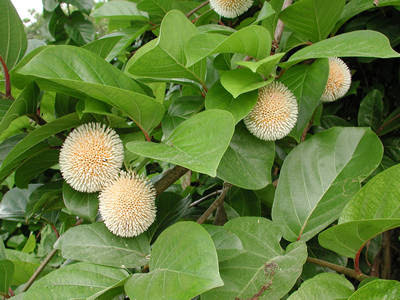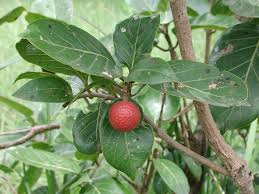Nauclea latifolia Sm.
| Botanical Name | Nauclea latifolia Sm. |
| Order: | Gentianales |
| Family: | Rubiaceae |
| Genus: | Nauclea |
| Species: | N. latifolia |
| Common Names: | Pin cushion tree (English), |
Plant Synonyms
Sacocephalus esculentus; Sacocephalus latifolius; Sacocephalus russeggeri.
Plant Local Names
Nigeria: Hausa: Tafashiya, Yoruba: Egbesi
Plant Habitat
Savanna, Wet soils among rocks.
Plant Material of Interest
Bark, leaf, roof, stem bark, root bark.
Plant Description
Tree up to 914cm, older ones have several large stems arising from a common stalk. Samller shrub-like specimens are very straggling with open growth and long, drooping and interlacing branches. The crown, in spite of the size of the leaves, is fairly open. Bark is green or brown and dull in older trees. Scales are up to 30.5cm in length. Slash is yellow with crimson streaks. Leaves large and rounded with tongued tip, averagely 17.8cm long and 8cm wide (sometimes up to 25cm long and 12.5cm wide). Upper surface is dark shinning green with pale venation, and a short red leaf stalk. Flowers (Feb.) are in balls about 2.54cm in diameter but fade very quickly. The balls are composed of hundreds of small flowers yellowish in colour, tabular 5-lobed corolla with shiny white pistil and a “corn” shaped long stigma. Flowers are sweet scented and have 5-stamen (small) attached to the inside of the corolla. Fruits vary somewhat in shape and size but roughly or oval, 2.54- 7.6cm in diameter and dark-red brown (Kaey et. al., 1964)
Plant Used Parts
Plant Uses
Plant Therapeutic Action
Plant Precaution for Use
Plant Adverse Effect
Plant Contraindication
Plant Dosage Forms
Plant Dosage
Plant Storage
Plant Chromatographic Fingerprint
Plant Constituents
The key constituents are indole alkaloids, glycoalkaloids and saponins (Iwu et. al., 1999). Leaves contain angustine (0.0022%), cadambine (0.016%), 3-alpha-dihydrocadambine (0.032%), edeoxtetrahydrocordifoline (0.004%), nauclamide A(0.0016%), naucleamide E (0.0008%), naulafine (0.0032%), strictosamide (0.15%) and 10-hydroxystrictosamide (0.008%) (Quinnn, 2006).
The stem contains fluoride (0.25ppm). Stem bark contains angustine (0.00661%), angustoline (0.00661%), 19-O-ethylaugustoline (0.00058%), nauclefine (0.00176%), Sm, Co, Mn, Au and angustidine (0.0017%). Its root contains Al, K, V, Na, Sc, Ca, Br, Zn, Mg, La, Cs, C, 19-O-ethylaugustoline (0.0008%), angustoline (0.003%), 9-epiaucleidial (0.004%), daucosterol, 3-O-6’-stearoyldaucosterol, decarbomethoxynauclechine, nauclefine (0.0024%), nauclefolonine (0.0005%), naucleidinal (0.00686%), naufoline, Quinnovic acid-3-O-alpha-L-rhamnopyranoside (0.093%), Quinnovic acid-3-O-beta-D-fucopyranoside (0.093%), rotundic acid, squalene, 21-O-methylstrictosamide aglycone (0.0023%), 21-O-ethylstrictosamide aglycone (0.00026%). Root back contains decarbomethoxynauclechine, naufolone, and strictosamide (0.25%). The fruit contains naucledal, epinaucledal and palmitic acid. The bark and wood contain strictosidine lactam (Quinnn, 2006) and Naucleamides A- E. In addition, present in the plant are naucletine and parvine.


